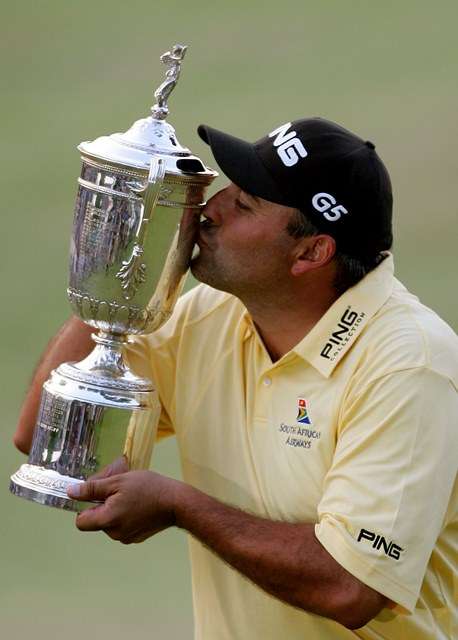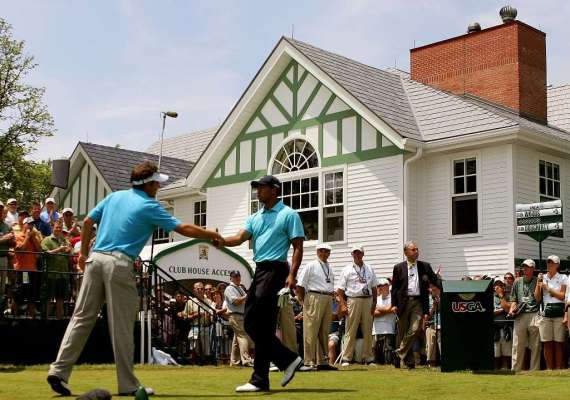Featured
Oakmont – this brute will test every facet of a player’s game

Say your prayers: The infamous Church Pews bunker that sits between the 3rd and 4th fairways (photo by Getty Images)
By John Huggan
When the US Open makes its eighth visit to the Oakmont Country Club near Pittsburgh later this month, the storied course will look a bit different than it did the last time America’s national championship was held there. Remarkably, that statement was equally true in 2007, when Angel Cabrera’s five-over par total was good enough to secure victory. In the years between Ernie Els’ 1994 win and ’07, as many as 7,000 trees were removed from the historic property. And since then, another 7,500 have disappeared.
Don’t get the wrong impression, though. The course widely reputed to be the toughest in America isn’t going to play any easier this time around. Still in place will be the traditional thick rough, narrow fairways, penal bunkering and borderline silly-fast greens. The record-low five-under-par aggregate shot by Els, and Johnny Miller in 1973, is likely to go unchallenged. Miller’s closing 63 that year – on an Oakmont softened by rain and a greenskeeper who mistakenly left sprinklers on overnight – remains a source of open embarrassment to the club. And the USGA, who produced what became the ‘Massacre at Winged Foot’ one year later as if to put the players in their place.
Still, for all its obvious brutality – and despite the notion that it would be the best and most interesting course on the planet if the rough were eliminated all but completely – Oakmont manages to be one of the most revered Major championship venues. A list of past winners containing the names Tommy Armour, Jack Nicklaus (the 1962 US Open was his first tournament victory as a professional) and Ben Hogan helps in that regard, but there has to be more to it than that.
“Oakmont is the exception that proves the rule,” says 2006 US Open champion Geoff Ogilvy, who finished T-42 there in defence of the title he won at Winged Foot 12 months previously. “In fact, it breaks every rule for me. Yet I love the place. It is a bit like Muirfield in its set-up. It is narrow and has thick rough. That’s their thing. All the best courses have a ‘thing.’ Augusta National is width and really fast greens. Carnoustie is narrow and long rough. The lifelong mentality of a membership is hard to get away from. That’s what they do.
“Generally, when someone has attempted to build the hardest golf course possible it has usually been atrocious. No fun to play. Too penal. And not really that great. But that has been the mentality at Oakmont from day one. It was built to be the hardest and it is constantly getting massaged or adjusted to make it harder and harder.
“Traditionally, that would lead me to believe that the course is no good. But it is amazingly good. It is incredible and one of my favourite courses. It is right up there in the conversation when it comes to the debate over what is the absolute best.
“Yes, it is penal. But it is such a beautiful place. The greens are amazing. It has a great ‘look’ about it. I would prefer it with less rough. But I’m a ‘width’ guy. And that is the one thing that wouldn’t fit with their aim to make it as difficult as possible. It would definitely be more fun to play with less rough. And more interesting. It would be St Andrews-like. It has really penal bunkers. It has really crazy, sloping greens. If it let you play each hole the way you wanted, it would be fascinating. You would see guys do a lot of different stuff and come up with a lot of different theories.”
But that is neither the traditional US Open way (apart from the disastrous Chambers Bay experiment last year), nor the modus operandi at Oakmont.
Indeed, the membership take huge pride in the difficulty of a course that ‘boasted’ a 300-yard par-three nine years ago. The speed of the greens is another source of pleasure. It is no coincidence that the now ubiquitous green speed measuring tool, the Stimpmeter, came into being back in the 1930s because of the slippery surfaces so beloved of Oakmont’s collection of sadists/masochists. This year, the target reading is apparently 14, the same as it was in ’07 when the man who has played golf better than anyone else ever has – Tiger Woods – shot a third round 69 when at the top of his game. Obvious conclusion? There was something wrong with the course.
“Taking the trees out at Oakmont was probably a huge step for the committee in charge,” says Ogilvy. “They actually hid it from the membership. I think a few hundred had gone before people started to notice what they were doing. They knew it would be controversial. But once they got to a certain point people could see it was the right decision. If they had been more upfront though, they might not have got started.
“So you never know, they might come to the same conclusion about the rough. It’s a similar mind-set. Maybe they will be prepared to go for a bit more rough and what I call ‘flier’ rough, the sort that puts doubt in the minds of players and what you see a lot of in Scotland and Ireland. From that stuff you are really just guessing about how far the ball will fly and roll. Which wouldn’t be a stretch. Oakmont is already a very British-style course in the way you have to play it. Except for the speed of the greens of course. At Oakmont it can get a bit crazy.”

Kiss of life: 2007 winner Angel Cabrera (photo by Getty Images)
Okay, so how will the best players on the planet set about slaying this monster?
“The winner will be the guy who has his ‘patience-hat’ on longer than anyone else,” continues Ogilvy. “He will have hit it straight off the tee. Length is an advantage but not a crazy advantage. The shorter club you can hit to those greens the easier it will be. But he will have to use his brain.
He will have to be patient. And he is going to have putts and chips that don’t make any sense and seem completely ridiculous. It will feel unfair at times. But for the body of work over 72-holes it isn’t unfair at all. It’s pretty democratic. Anyone who plays well will do well.
“A great short game is another prerequisite for winning. A lot of times scoring well at Oakmont is all about staying under the hole. There are greens where a 30-foot putt uphill is way better than ten-footer downhill. It’s very much a course where – and this is why it is so great – it is all about answering one question: ‘Where do I want to be to leave the easiest possible next shot?’ All the great courses do that to an extent but Oakmont does it as much as anywhere. The wrong spot is impossible and the right spot is playable. So you are constantly concerned with where to miss. Which is why patience is so important.”
Still, it remains a source of regret that the lasting impression taken from any Oakmont US Open is the thickness and length of the rough. That long grass is golf’s most boring hazard has clearly never dawned on the membership.
Perhaps most damningly, it eliminates the prospect of golf’s most exciting challenge for players at the highest level – the risky recovery shot. Instead of taking aim at a distant target when maybe they shouldn’t – thereby bringing all kinds of numbers into play – the pros will simply pitch back into the fairway and make a four or a five every time.
“In my eyes the course would be better with only a little rough,” contends Ogilvy. “But that is a subjective thing. It would definitely be more fun, though. More width would mean the field wouldn’t be directed as to where to hit the ball off the tee. They would be free to create their own angles into the greens. That would be their decision.
“Depending on the pin positions, you’d see guys going way left and way right. You’d see guys teeing-off with drivers. You’d see others hitting irons. On almost every hole there would be a difference of opinion. It would be almost impossible to predict what anyone will use off the tee. Oakmont is a good enough design to cope. The bunkers are penal enough and the greens demanding enough to encourage all of the above. It would provide such a great test.”
And that is surely the one area of unanimity when this brute of a course is under discussion. This US Open will be a great test of everything other than imagination and flair. Straight driving rather than accurate driving will take precedence.
And the winning score will likely be over-par, just as it was last time. Oakmont: the toughest of them all.








